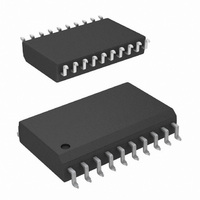LM1972M/NOPB National Semiconductor, LM1972M/NOPB Datasheet - Page 9

LM1972M/NOPB
Manufacturer Part Number
LM1972M/NOPB
Description
IC AUDIO ATTENUATR W/MUTE 20SOIC
Manufacturer
National Semiconductor
Type
Audio Attenuatorr
Datasheet
1.LM1972MNOPB.pdf
(12 pages)
Specifications of LM1972M/NOPB
Applications
Consoles, MIDI
Mounting Type
Surface Mount
Package / Case
20-SOIC (7.5mm Width)
Attenuator Step Size
0.5/1dB
Number Of Bits
16
Number Of Channels
2
Power Dissipation
150mW
Supply Current
4mA
Operating Temperature (min)
0C
Operating Temperature (max)
70C
Operating Temperature Classification
Commercial
Package Type
SOIC W
Lead Free Status / RoHS Status
Lead free / RoHS Compliant
Other names
*LM1972M
*LM1972M/NOPB
LM1972M
*LM1972M/NOPB
LM1972M
the signal level being measured is of the same frequency such
that a true indication of crosstalk may be obtained. Also, to
ensure an accurate measurement, the measured channel's
input should be AC grounded through a 1 μF capacitor.
CLICKS AND POPS
So, why is that output buffer needed anyway? There are three
answers to this question, all of which are important from a
system point of view.
The first reason to utilize a buffer/amplifier at the output of a
μPot is to ensure that there are no audible clicks or pops due
to attenuation step changes in the device. If an on-board
bipolar op amp had been used for the output stage, its re-
quirement of a finite amount of DC bias current for operation
would cause a DC voltage “pop” when the output impedance
of the μPot changes. Again, this phenomenon is due to the
fact that the output impedance of the μPot is changing with
step changes and a bipolar amplifier requires a finite amount
of DC bias current for its operation. As the impedance
changes, so does the DC bias current and thus there is a DC
voltage “pop”.
Secondly, the μPot has no drive capability, so any desired
gain needs to be accomplished through a buffer/non-inverting
amplifer.
Third, the output of a μPot needs to see a high impedance to
prevent loading and subsequent linearity errors from ocurring.
A JFET input buffer provides a high input impedance to the
output of the μPot so that this does not occur.
FIGURE 10. Digitally-Controlled Logarithmic Gain Amplifier Circuit
FIGURE 11. n-μPot Daisy-Chained Circuit
9
Clicks and pops can be avoided by using a JFET input buffer/
amplifier such as an LF412ACN. The LF412 has a high input
impedance and exhibits both a low noise floor and low THD
+N throughout the audio spectrum which maintains signal in-
tegrity and linearity for the system. The performance of the
system solution is entirely dependent upon the quality and
performance of the JFET input buffer/amplifier.
LOGARITHMIC GAIN AMPUFIER
The μPot is capable of being used in the feedback loop of an
amplifier, however, as stated previously, the output of the
μPot needs to see a high impedance in order to maintain its
high performance and linearity. Again, loading the output will
change the values of attenuation for the device. As shown in
Figure 10, a μPot used in the feedback loop creates a loga-
rithmic gain amplifier. In this configuration the attenuation
levels from Table 1, now become gain levels with the largest
possible gain value being 78dB. For most applications 78dB
of gain will cause signal clipping to occur, however, because
of the μPot's versatility the gain can be controlled through
programming such that the clipping level of the system is
never obtained. An important point to remember is that when
in mute mode the input is disconnected from the output. In
this configuration this will place the amplifier in its open loop
gain state, thus resulting in severe comparator action. Care
should be taken with the programming and design of this type
of circuit. To provide the best performance, a JFET input am-
plifier should be used.
1197814
www.national.com
1197813











